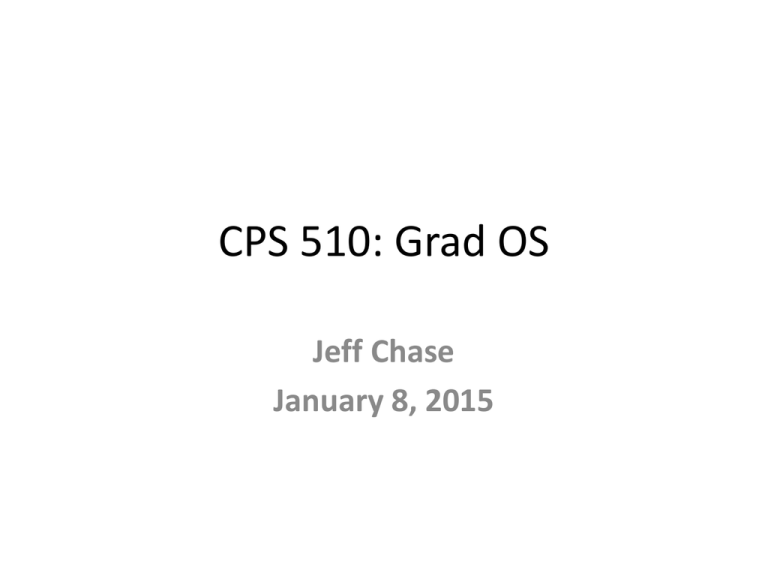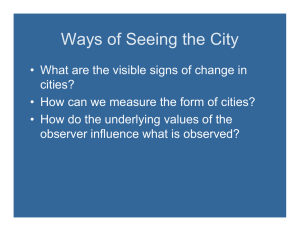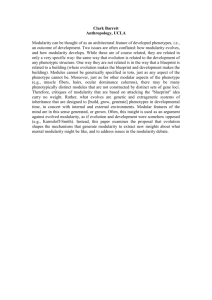CPS 510: Grad OS Jeff Chase January 8, 2015
advertisement

CPS 510: Grad OS Jeff Chase January 8, 2015 About CPS 510 • CPS 510 is about operating systems research • You will read a lot of old and new papers • You will perform a semester-long research project • What CPS 510 is not about • Learning basic operating systems concepts • You should know this already • Who should take it? • Graduate students and smart undergrads About this offering of CPS 510 • Syllabus and reading list are online • 12-14 papers for you to read and digest…and some others • Reading list is subject to “adjustment” • “Less than one paper per class” • Grading • Exams (50%): one midterm and a final • Projects and labs (50%) • “Other factors”: adjustments up to half a letter grade • • • • Participation and engagement Bring questions and opinions on the reading to class What will you say if I ask you? Read one “classic paper” of your choice and post a short report About exams • Exams focus on concepts in the papers, as discussed in class. • • • • motivation and lessons what, why, how tools, new concepts, philosophy background concepts are “fair game” Optional Over the past two decades, there has been a huge amount of innovation in both the principles and practice of operating systems Over the same period, the core ideas in a modern operating system — protection, concurrency, virtualization, resource allocation, and reliable storage — have become widely applied throughout computer science. Whether you get a job at Facebook, Google, Microsoft, or any other leading-edge technology company, it is impossible to build resilient, secure, and flexible computer systems without the ability to apply operating systems concepts in a variety of settings. …Because operating systems concepts are among the most difficult in computer science, a top to bottom approach is the only way to really understand and master this important material. About reading papers • Older papers: introduce the “canon” • “A collection or list of sacred works” • Newer papers: advances and research topics • It’s OK to disagree! • Papers are different from textbooks. They: • Report contributions and set them context. • Explain methodology in sufficient detail for the reader to accept and even reproduce the results. • Present multiple levels of detail: some that matter, and some that don’t. • Are dressed to impress. • Are products of their time. • It is not necessary to learn every detail! Abstractions, hardware reality Programs Applications Threads Virtual Memory Files, web OS Atomic Test/Set Hardware Page Tables Disk , NIC Hardware Concurrent program Higher-level synchronization (reader-writer functions) High-level synchronization (locks, monitors, semaphores) Hardware (load/store, interrupt enable/disable, test&set) RPC First, a little philosophy • Structure and Interpretation of Computer Programs • Harold Abelson and Gerald Jay Sussman • Longtime book for MIT’s first course in CS “Underlying our approach to this subject is our conviction that ‘computer science’ is not a science and that its significance has little to do with computers… Mathematics provides a framework for dealing precisely with notions of ‘what is.’ Computation provides a framework for dealing precisely with notions of ‘how to.’” Some Challenges • Many common, important problems • • • • • • Fault tolerance Coordination of concurrent activities Geo. separated but linked data Large-scale data sets Protection from mistakes and attacks Interactions with many people • All of these problems lead to complexity Complexity • How do we control complexity? • Build abstractions that hide unimportant details • Establish interfaces and boundaries • Enable composition of simple, well-defined components • None of this is specific to computer systems • Just principles of good engineering • Applies to other human structures as well • But computer systems must establish a foundation and framework for extension/evolution: a platform. Key questions for semester • • • • What are the right abstractions? How should we enforce modularity/isolation? How do we ensure fair, efficient allocation? What is the basis for trust? • We will read a lot of papers this semester • Useful to think about them in terms of these questions • Sometimes goals are in tension (e.g., modularity vs. efficiency) • Good papers explain the trade-offs • This semester will emphasize trustworthy computing topics. Bill Gates statement on Trustworthy Computing (2002) Today, in the developed world, we do not worry about electricity and water services being available. …Computing falls well short of this... The events of last year - from September's terrorist attacks to a number of malicious and highly publicized computer viruses reminded every one of us how important it is to ensure the integrity and security of our critical infrastructure, whether it's the airlines or computer systems. …Microsoft and the computer industry will only succeed in that world if CIOs, consumers and everyone else sees that Microsoft has created a platform for Trustworthy Computing. Every week there are reports of newly discovered security problems in all kinds of software, from individual applications and services to Windows, Linux, Unix and other platforms. …. Our new design approaches need to dramatically reduce the number of such issues that come up in the software that Microsoft, its partners and its customers create. …Eventually, our software should be so fundamentally secure that customers never even worry about it. No Trustworthy Computing platform exists today. 1988 • 2000 2001 2002 CodeRed (2001) • • • 1999 Exploited an overflow in the MS-IIS server 300,000 machines infected in 14 hours SQL Slammer (2003) • • Exploited an overflow in the MS-SQL server 75,000 machines infected in 10 minutes [This content courtesy of Dave Levin] 2003 OS Structure Before After Protection and trust Storage layers User program Database (x-action begin, commit) File system (open, close, read, write) Hardware (Block read/write) Programming Labs • Done in groups of one or two • Email me groups by January 17 • Two labs 1. Concurrency and synchronization (50%) 2. File systems /distributed storage (50%) Research Projects • Done in groups of three • Five phases 1. 2. 3. 4. 5. Form groups (due after concurrency project) Write proposal (20% of project grade) Write status report (10% of pg) Write final report (60% of pg) Give presentation (10% of pg) Two roles of the OS OS as illusionist OS as government Main government functions • Resource manager (who gets what and when) • • • • Lock acquisition Processes Disk requests Page eviction • Isolation and security (law and order) • Access control • Kernel bit • Authentication Two roles of the OS Abstractions Government Modularity Simplicity Hide messy reality Law and order Fair, efficient allocation Source of trust Two roles of the OS Abstractions Government Modularity Simplicity Hide messy reality Law and order Fair, efficient allocation Source of trust How does OS enforce modularity? Two roles of the OS Abstractions Government Modularity Simplicity Hide messy reality Law and order Fair, efficient allocation Source of trust How does OS ensure fair allocation? Two roles of the OS Abstractions Government Modularity Simplicity Hide messy reality Law and order Fair, efficient allocation Source of trust What is the basis for trust?



